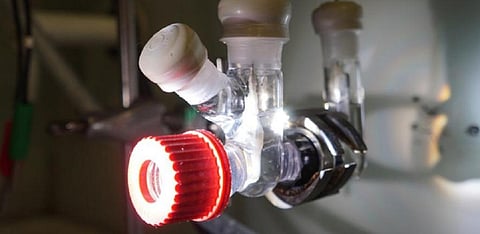

Researchers from the University of Cambridge, the United Kingdom have developed a system that can transform plastic waste and greenhouse gases into sustainable fuels and other valuable products – using just the energy from the sun.
A paper on the research, Photoelectrochemical CO2-to-fuel conversion with simultaneous plastic reforming, was published in Nature Synthesis journal January 9, 2023.
Conversion of greenhouse gases like carbon dioxide and plastics — two of the biggest threats facing the natural world — into value-added products, driven by solar energy, is an important step in the transition to a more sustainable, circular economy, the study said.
However, it is challenging to convert the two simultaneously in an integrated process.
The researchers developed an integrated reactor with two separate compartments: One for plastic and one for greenhouse gases. The reactor uses a light absorber based on perovskite — a promising alternative to silicon for next-generation solar cells.
The team designed different catalysts, which were integrated into the light absorber. By changing the catalyst, the researchers could then change the end product.
The process of photoelectrochemical CO2-to-fuel production coupled to plastic-to-chemical conversion. Photo: Univeristy of Cambridge
Tests of the reactor under normal temperature and pressure conditions showed the reactor could efficiently convert polyethylene terephthalate (PET) plastic bottles and CO2 into different carbon-based fuels such as CO, syngas or formate, in addition to glycolic acid.
The reactor produced these products at a rate that is also much higher than conventional photocatalytic CO2 reduction processes.
The paper’s senior author, Erwin Reisner, from the Yusuf Hamied Department of Chemistry, in a statement on the university website said:
Converting waste into something useful using solar energy is a major goal of our research. Plastic pollution is a huge problem worldwide and often, many of the plastics we throw into recycling bins are incinerated or end up in landfills.
Other solar-powered ‘recycling’ technologies hold promise for addressing plastic pollution and for reducing the amount of greenhouse gases in the atmosphere, but to date, they have not been combined in a single process, the statement added.
“Generally, CO2 conversion requires a lot of energy, but with our system, basically you just shine a light at it, and it starts converting harmful products into something useful and sustainable,” said co-first author Motiar Rahaman in the statement.
“Prior to this system, we didn’t have anything that could make high-value products selectively and efficiently,” Rahaman added.
Reisner has recently received new funding from the European Research Council to help the development of the solar-powered reactor, the statement added. Over the next five years, the team hopes to develop the reactor further to produce more complex molecules.
Similar techniques could someday be used to develop an entirely solar-powered recycling plant, the researchers added.